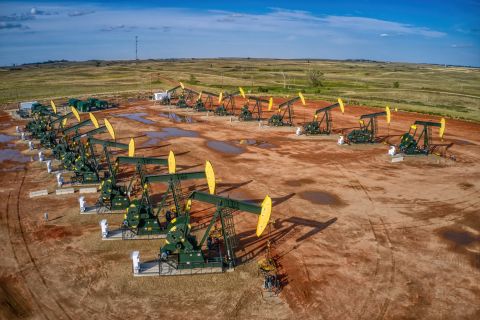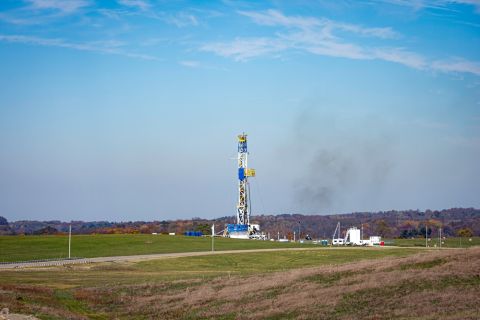U.S. oil producers could expand daily output by 1 million barrels (MMbbl) next year, or by as little as 100,000 bbl, with the wide gap creating huge uncertainty as OPEC officials gather this week to weigh production curbs.
Shale output has routinely defied naysayers over the past three years as U.S. production has surged to nearly 13 million barrels per day (bbl/d), making the nation the world’s largest crude oil producer and a major exporter with an average of just under 3 MMbbl/d so far this year.
But the outlook for 2020 comes with growing skepticism from those inside the industry—and should growth fall short, it could shift the balance of power in world supply back to OPEC.
An increase in U.S. crude output by 1 MMbbl/d would satisfy nearly all of the 1.2 MMbbl/d increase in world demand next year, the International Energy Agency expects.
That would keep a lid on prices, pressure OPEC to extend production cuts and leave shale producers still trying to achieve elusive profits. As a result, most industry executives and consultants said they expect slower U.S. shale growth.
OPEC and its allies, which have cut output by 1.2 MMbbl/d, meet in Vienna on Dec. 5-6 to weigh their next steps. The current supply cuts now run through to March.
“I don’t think OPEC has to worry that much more about U.S. shale growth long term,” Pioneer Natural Resources CEO Scott Sheffield said last month, noting oil majors are the last companies aggressively drilling in the Permian Basin, the top U.S. shale field.
Producers have reduced the number of oil rigs operating for a record 12th month in a row, sidelining a quarter of the country’s drilling rigs in the past year, according to service firm Baker Hughes.
Shale producers such as Pioneer, Range Resources, EQT Corp., and Whiting Petroleum have reduced production targets and cut staff, aiming to meet investor demands for higher returns and debt reduction.
“This was a hard decision to make and one we did not take lightly, but ultimately it was a necessary, prudent action,” Range Resources CEO Jeff Ventura told Reuters of his firm’s actions.
The company has sold $1.1 billion in assets, closed offices and reduced staff, using proceeds to buy back shares and reduce debt amid weaker oil prices.
No Longer A Cottage Industry
The cuts, however, have only slowed U.S. crude production gains, not halted them. Output gains by larger oil companies and a lag effect from smaller companies’ reductions have wildly varying 2020 output forecasts.
U.S. oil production next year will rise 1 MMbbl/d, U.S. Energy Information Administration predicted, with shale accounting for most of that.
Energy researchers IHS Markit and Wood Mackenzie separately put gains at 440,000 bbl/d to 450,000 bbl/d, while Goldman Sachs Group estimated a gain of 600,000 bbl/d.
Global inventories are “a little bit oversupplied,” said Ian Nieboer, an analyst with researcher RS Energy Group, which puts U.S. growth at about 100,000 bbl/d next year. “It puts a lid on any optimism.”
Oil majors Exxon Mobil Corp. and Chevron Corp. have not pulled back from their Permian plans. Exxon is targeting 1 MMbbl/d of production by 2024 in the Permian, and Chevron is aiming for 900,000 bbl/d a year earlier. Top Permian producer Pioneer also recently increased its forecast for this year’s oil output and aims for a mid-teens percentage gain over several years.
Oil majors are less susceptible to lower prices and will continue to invest in the Permian, said Muqsit Ashraf, senior managing director for energy at Accenture Strategy, adding that the largest independents also are likely to expand output.
Increased scale will give the majors an edge in the Permian, said Chris Snyder, an oil analyst at Deutsche Bank.
“Historically shale was a cottage industry, with one well drilled at a time and each done differently,” said Snyder. “As we move to this manufacturing approach, that favors the skill sets of majors. They’re excellent project managers.
“The debate right now in the U.S. market is ‘does growth matter anymore?’ Clearly, [producers] are favoring cash production and generation over growth,” Snyder said, alluding to the thousands of wells that have been drilled but not completed and hooked up to pipelines.
Recommended Reading
EQT, Equinor Agree to Massive Appalachia Acreage Swap
2024-04-15 - Equinor will part with its operated assets in the Marcellus and Utica Shale and pay $500 million to EQT in exchange for 40% of EQT’s non-operated assets in the Northern Marcellus Shale.
EQT Ups Stake in Appalachia Gas Gathering Assets for $205MM
2024-02-14 - EQT Corp. inked upstream and midstream M&A in the fourth quarter—and the Appalachia gas giant is looking to ink more deals this year.
Is Grayson Mill the Next Bakken Domino to Fall After Chevron-Hess?
2024-01-31 - As E&Ps look to bulk up outside of the Permian Basin, EnCap-backed Bakken player Grayson Mill Energy is reportedly exploring a sale valued around $5 billion.
Ohio Oil, Appalachia Gas Plays Ripe for Consolidation
2024-04-09 - With buyers “starved” for top-tier natural gas assets, Appalachia could become a dealmaking hotspot in the coming years. Operators, analysts and investors are also closely watching what comes out of the ground in the Ohio Utica oil fairway.
EQT, Equitrans Midstream to Combine in $5.5B Deal: Reports
2024-03-11 - EQT Corp.'s deal would reunite the natural gas E&P with Equitrans Midstream after the two companies separated in 2018.




